―
Internet
Connection Successful!
SpaceX Starlink works in Ukraine!
―
On February 28, 2022, a brief tweet stating
a user had successfully linked to the internet grabbed the world’s attention.
The Twitter message was uploaded by Ukrainian developer Oleg Kutkov. What's so
special about this short tweet that it inspired and gave hope to people around
the world?

In February, Russia attacked Ukraine and
destroyed its entire communications network. On short notice, the Ukrainian
government submitted a request for Starlink service, invented by the SpaceX
company of Elon Musk, stating that their country needed means of communication
to protect civilians and rescue injured people.
SpaceX's Starlink is a technological system
that enables people anywhere to use the Internet by receiving signals between
thousands of cube satellites orbiting the earth and small local antennas on the
ground. With this system, one can connect to the Internet through Starlink
service even in mountainous areas, deserts, and developing countries where it
is difficult to establish a base station.
―
Ten
Seconds!
The
time it took for Oleg Kutkov to connect to the Internet
―
Ten seconds! That’s all the time it took for Oleg Kutkov to hook up to the internet.
Oleg Kutkov, who had purchased a Starlink satellite dish from an internet shopping mall a few months earlier and had been keeping it stowed away, connected his satellite dish outside the window as soon as he learned the news that Starlink would start service in his country, the Ukraine.It is no exaggeration to state that it is
owing to Starlink, a low-orbit satellite network, that the horrors of the
Ukrainian war are conveyed to the world in real time through social media. The
amazing development of personal satellite communications technology has made it
possible for the whole world to communicate in real time even amidst an urban
battlefield where every work of man is being reduced to rubble.
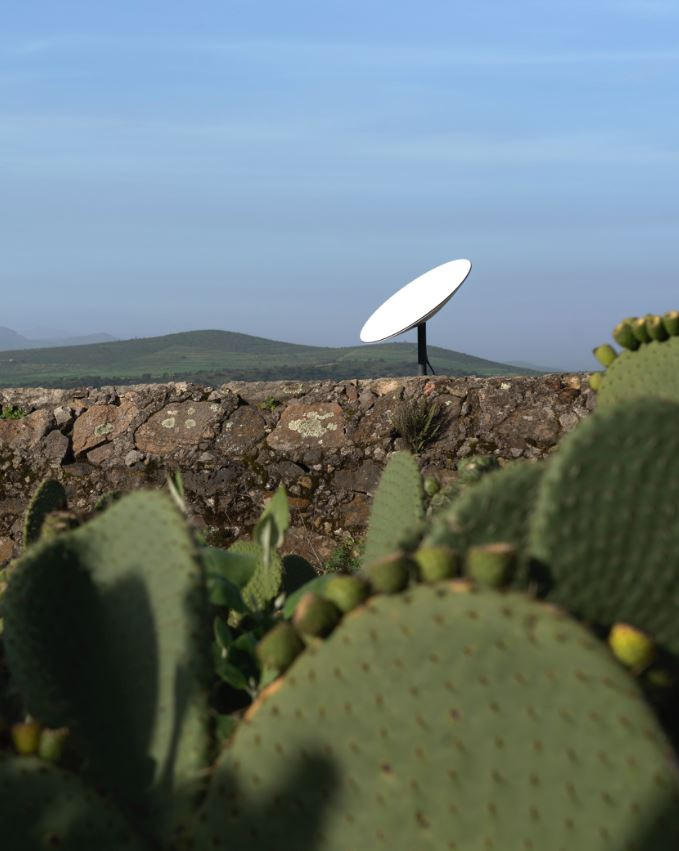
The
above photo is a Starlink radio wave receiving antenna. (Source: Starlink,
Inc.)
―
A
shooting star embroidering the sky?
>If
you make a mistake, you may be in big trouble!
―
Yet as with all new technologies, light and
dark coexist in the new technology called "Space Internet."
● In 2009 a black hunk of metal punched
through the roof of a British house! Surprisingly, it turned out to be a fuel
tank from Apollo 12, which was launched forty years earlier.
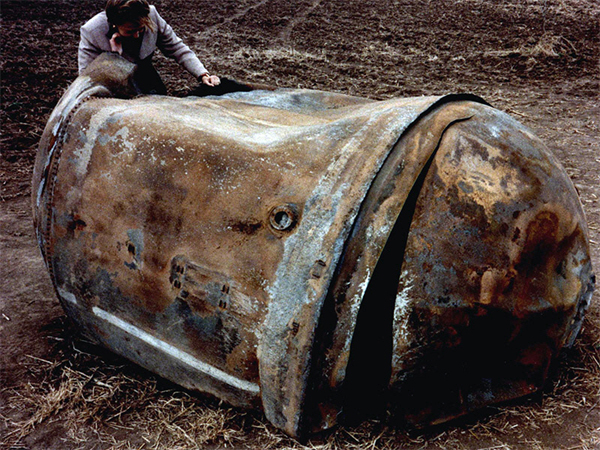
A Delta 2 projectile propellant tank landed
in Texas, USA in 1997 (Source: NASA)
● In 2011, a metal chunk weighing 2.5 tons
hurtled out of the heavens in the neighborhood of Beijing! It was a fragment
from the German space-borne X-ray telescope ROSAT that did not completely
incinerate in earth's atmosphere but plummeted to earth near Beijing, China.
According to the European Space Agency (ESA), it would have been a catastrophe
if the wreckage of the satellite had impacted in urban Beijing at the speed of
480 km/hr. Luckily it was a near miss, splashing into the sea just offshore
with a 7-minute orbital delay.
● In 2021, the core stage of the Chinese
Long March-5B rocket, over 30 meters in length and weighing 18 tons, spun out
of control and crashed to Earth! The wreckage, which held the world in bated
breath, luckily plummeted into the waters southwest of India.
● On April 4, 2022, a
huge metal ring 3m in diameter weighing 40kg fell into a village in India as they
prepared a village feast! The Indian Space Research Organization (ISRO) said
the metal mass is believed to be debris from a Chinese Changjeong-3B launched
on February 4 the previous year.
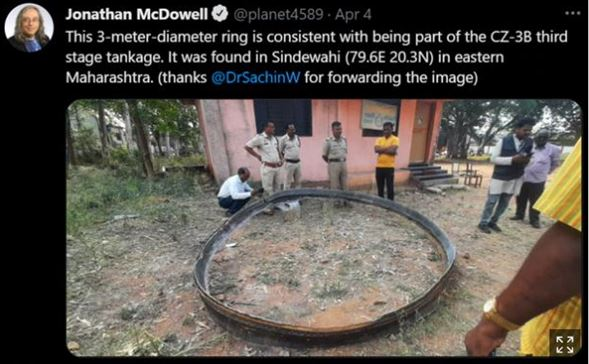
Tweet announcing that Chinese space debris fell on Indian village.
―
Burgeoning global market
for low-orbit satellites
―

The global low-orbit satellite market is
accelerating. Big players in the corporate world include "Starlink"
of SpaceX, led by Elon Musk, "Kuiper Systems," a subsidiary of
Amazon, and "OneWeb," a British space internet company.
◇ US SpaceX plans to launch 11,943
satellites
Elon Musk (CEO of SpaceX and Tesla) leads
the private space industry. The U.S. entrepreneur plans to launch 11,943
satellites weighing 227 kg into low-Earth orbit by 2027 to enable global
Internet access. Starlink began launching satellites in 2018 and has placed about
2,000 satellites in orbit so far.
◇ US Amazon plans to launch 3,236
satellites
American company Amazon is pursuing Project
Kuiper to provide global broadband intercommunication with 3,236 low orbit
satellites by 2029. Amazon says it will bring internet coverage to areas where
95% of humanity lives.
◇ UK ‘OneWeb’ plans to launch 2,700
satellites
OneWeb is a space internet company founded
in the UK in 2012 by Greg Wyler. In the first phase, about 700 satellites will
provide communication services from 2022, and in the second phase, about 2,000
satellites will be added to consolidate a global communication network.
―
Dead satellites form a huge
orbiting fleet of space junk
―
The problem is that fragments of artificial
satellites or satellites whose useful terms have expired become "space
junk" cluttering the heavens above earth's atmosphere.
According to the United Nations Office for Outer Space Affairs, a total of 12,554 satellites (including 1,290 not registered with the UN) have been launched into space since mankind launched the first satellite in 1957 until April 2022. Of these, only 8,569 satellites currently remain in orbit, while 3,983 satellites are known to have failed to reach orbit and plummeted back to terra firma or the sea.
According to the National Aeronautics and
Space Administration (NASA), more than 95% of the objects orbiting Earth are
useless space debris.
According to the European Space Agency
(ESA), there are about 36,500 pieces of space debris the size of a tennis ball
orbiting the Earth, with a total weight of 9,600 tons. If the scope of garbage
is expanded to objects as small as 1 mm, the number is estimated to be about
130 million.
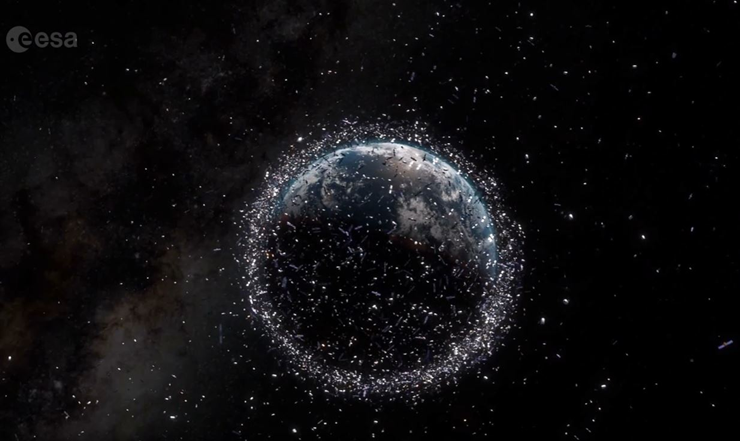
Image
of space debris floating around the Earth (Source: ESA)
All these flotsam and jetsam are orbiting
our planet at speeds about 7.5 km/s. At seven times the speed of a bullet,
that's a terrifying speed. Colliding with a 1cm-sized piece of aluminum
hurtling at this speed is equivalent to hitting a car weighing 1.5t at 50km/h.
A piece of metal the size of a fingernail becomes a weapon capable of
destroying a satellite or space station.
The "Global Risk Report" released
by the World Economic Forum in January 2022 warns that the increase in space
debris is causing damage to orbital and space equipment hosting facilities for
Earth's major systems, which could ignite already volatile international
tensions.
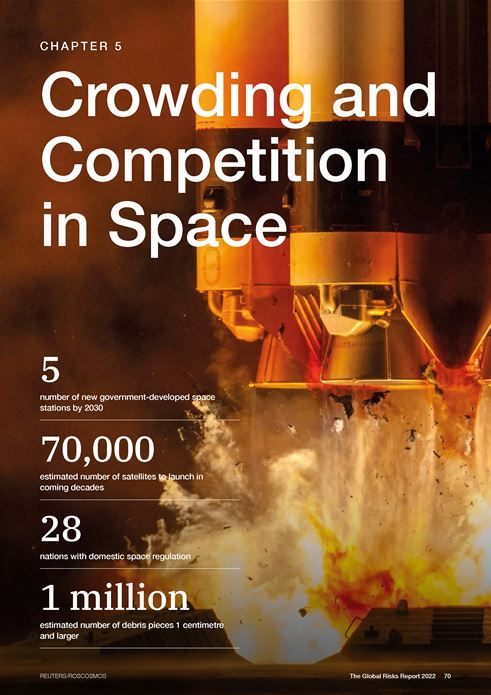
Report
source: https://www.weforum.org/reports/global-risks-report-2022
―
Global
warming expected to increase
>lifespan
of space debris by 40 years
lifespan
of space debris by 40 years
―
At the 7th "European Conference on Space Debris" hosted by the European Space Agency (ESA) in April 2021, a research team from the University of Southampton in the UK announced their finding that the hazards caused by space debris will increase due to global warming.
The process is as follows: Fragments
orbiting the Earth gradually decelerate due to trace gases surrounding our
planet, and slowly spiral in toward the Earth. As they reach Earth's thicker
atmosphere, most of them are incinerated and vaporize due to the tremendous friction
created as they pass through the lower layers of the air.
However, due to the increase in carbon
dioxide caused by fuel combustion, the density of the upper layers of the
atmosphere is lowered, and the attrition process of space junk takes longer. Already
CO2 increase has reduced 21% of
the atmospheric volume over 400 km since 2000, and it is predicted that
if CO2 levels double by 2100, the volume of air above 400 km may be
reduced by 80%.
This could increase the lifespan of orbiting space debris by up to 40 years and increase the amount of space debris by the appalling factor of about 50 times as much hazardous clutter in orbit!
―
Developing a vacuum cleaner may be the
key to avoiding a bolt out of the blue!
―
The first
proposals for solving space debris began in the late 1970s. However, despite
the urgent need for international cooperation due to the intertwined interests
among nations, no adequate solution emerged. At the G7 summit in 2021, the
issue of space debris was discussed on the agenda, but it was concluded without
any compelling solution.
Still, there is hope. Humanity has always come up with new solutions to meet new challenges.

◇ "LiBDO" ᅳ NASA's space waste disposal technology
Recently, NASA announced that it is
developing a new space waste disposal technology called “Lithium-ion Battery DeOrbiter”,
or “LiBDO” for short.
“LiBDO” is a technology in which the
built-in battery retires into a thermal runaway state and ignites when the
lifespan of the spacecraft is over, and the energy released as it goes out with
a flare is directed as "reverse thrust" to dislodge the satellite
from orbit. That is, the spacecraft finds its own grave without external help.
That's the theory of how it’s supposed to work.
◇ European Space Agency's (ESA) small space-cleaning
satellite “RemoveDEBRIS”
The European Space Agency (ESA) has plans
to collect space debris in earth orbit with nets or harpoons. In fact, the
European aircraft manufacturer Airbus and a British research team conducted an
experiment to launch a small cleaning satellite in 2018 intended for this
purpose but have not yet succeeded in capturing anything.
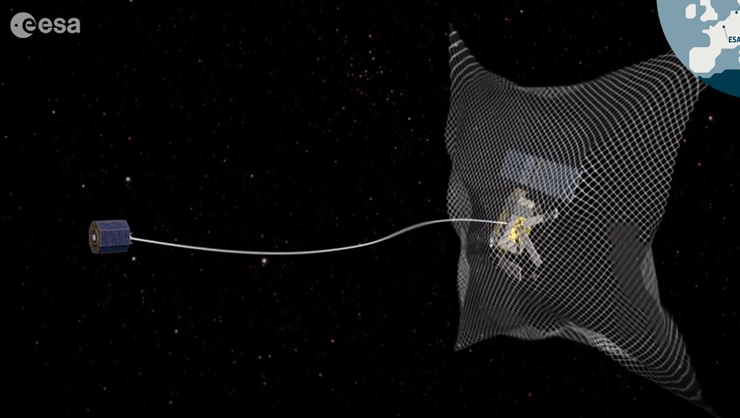
European Space Agency is working on a
project to collect space debris orbiting Earth with nets or harpoons. (Source:
ESA)
◇ Swiss startup ClearSpace's cleaning
satellite
The private sector is stepping up to tackle
the problem. In 2025, together with ClearSpace, a venture based at Ecole
Polytechnique Fédérale de Lausanne, Switzerland, they plan to launch their own
space debris collection mission. It is a method of incineration by launching a
cleaning satellite to collect space debris and then plunge it into the Earth's
atmosphere. These are viewed as undesirable homework assignments we’d rather
put off—yet if we fail to fulfill them the cost may be enormous.
◇ Astroscale's magnetic arm cleaning
satellite
Astroscale, a USA–Japan joint venture,
hopes to attract space debris with magnetic arms and then transfer it to the
atmosphere where it safely burns up. Last year, they succeeded for the first
time ever in capturing a small satellite with a magnetic arm.
However, even if government agencies and
private companies develop technologies to deorbit space waste, most of these
technologies will be useless if, owing to global warming, they cannot
incinerate the space waste before it strikes the earth and causes untold
damage.
Whether handling space waste will become a
new industry for humanity, or an imposingly difficult problem to solve, as in
the movie Space Sweepers, we all are watching with ever-increasing interest.
Reference
* Link to European Space Agency presentation:
https://conference.sdo.esoc.esa.int/proceedings/sdc8/paper/178
* If you wish to check the list of satellites launched into space from Earth so far, click the link.
Online Index of Objects Launched into Outer Space
https://www.unoosa.org/oosa/osoindex/search-ng.jspx
Written by Sharon Choi
Director of Planning
Sunhak Peace Prize Secretariat

